Planning your own trip? Prepare for your trip
Use Rough Guides' trusted partners for great rates
Book your individual trip, stress-free with local travel experts
Despite its tumultuous history, Vietnam has bounced back to become a big-hitter on the Southeast Asian travel circuit. Unsurprisingly, from a country so long and skinny, there’s plenty of variety on offer: emerald paddy fields and white-sand beaches, full-tilt cities and venerable pagodas, limestone islands looming dramatically out of the sea, vast caves, craggy mountains, and friendly minority communities – with their elaborate tribal costumes and age-old customs. Travel to Vietnam and you’ll be met with warmth and curiosity. Add to that, some of the region’s most nuanced cuisine, and you’re onto a winner.
While Hanoi, Ho Chi Minh City and the other major centres are intriguing enough, it’s Vietnam’s striking landscape that most impresses. Rugged mountains hug the west, bordering Cambodia and Laos; to the east lies the South China Sea – or the East Sea, as the Vietnamese call it. To the north and south, the land fantails out into the splendid deltas of the Red River and the Mekong, and it’s in these regions that you’ll encounter the paddy fields, dragonflies, buffaloes and conical-hatted farmers that constitute the classic images of Vietnam.
As for wildlife, the discovery in recent years of several previously unknown species of plants, birds and animals showcases the wealth of Vietnam’s biodiversity. This makes the improving access to the country’s national parks all the more gratifying for travellers wanting to visit Vietnam.
Travel to Vietnam and you’ll discover there is no shortage of beautiful and intriguing places to explore. Experience the buzz of vibrant Ho Chi Minh City, or captivating Hanoi, with its lively Old Quarter and mouth-watering street food, while the alluring riverside town of historic Hoi An in central Vietnam makes for a more mellow experience.
The Central Highlands affords fantastic trekking opportunities and other outdoor pursuits, with the breezy mountain town of Da Lat providing the ideal base, while a visit to the remote upland regions of central and northern Vietnam is likely to focus on the ethnic minorities who reside there.
Explore the pancake-flat rice lands of the Mekong Delta with its wonderful floating markets, and meander between Ha Long Bay’s striking limestone forested islands.
Of course, a visit to Vietnam wouldn’t be complete without some relaxing beach time. Take your pick from the gorgeous golden beaches in the south, such as Doc Let beach, on the Hon Khoi Peninsula, and enjoy some superb swimming and snorkeling – as well as exquisite seafood.
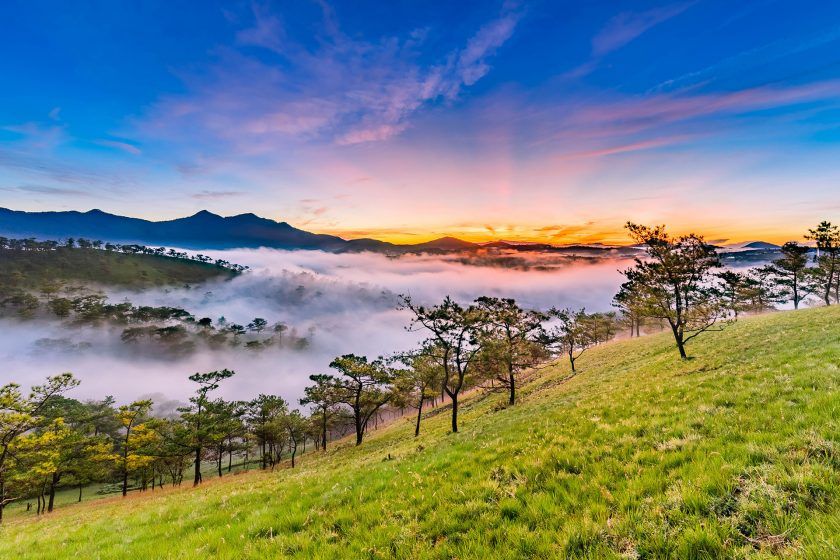
Sunrise in Golden Valley near Da Lat © TBone Lee/Shutterstock
Vietnam is long and slender, with different regions subject to different weather conditions at any one time, which makes figuring out the best time to visit Vietnam somewhat tricky.
The country has a tropical monsoon climate. If you’re visiting the south of the country the driest months tend to be between December and April, while the north of the country is typically driest in spring and autumn.
Within this broad weather picture are regional variations, with differences in altitude also key to varying temperatures. Whereas the south tends to have a year-round tropical climate, the north is considerably cooler in winter.
You can still enjoy a visit to Vietnam during the rainy season, but it’s worth bearing in mind that if you’re intending to go trekking, monsoon downpours can mean flooding in certain areas, and transport can be severely disrupted. You’ll also have to put up with a lot more mosquitoes. On the plus side, there are fewer visitors. Find out more about the best time to visit Vietnam here.
The number of international flights heading to Vietnam has been steadily increasing of late – a fair sign of the country’s burgeoning popularity as a tourist destination.
The vast majority of visitors fly into Ho Chi Minh City and Hanoi, although a fair chunk of visitors still take the cheaper option of an indirect flight routed through Bangkok, Singapore or Hong Kong.
Taking an indirect flight might be your only option if there are no direct flights available from where you intend to travel. While you can fly direct from London, for example, there are no direct flights from Ireland, North America, New Zealand, and very few from Australia. Take a look at Skyscanner for options.
If you’re coming from one of Vietnam’s neighbouring countries, you can fly from several cities, taking advantage of the low cost flights available through budget airlines.
Or, you can enter Vietnam overland from China, Laos, or Cambodia. It’s pretty simple as long as you have the appropriate visa, and this option means you can see more of the region than you would if you simply jetted in.
There are several options for travel within Vietnam. Though still a little rough around the edges, its transport network is continuing to improve. Comfortable buses operate regularly and fares are cheap, or you can travel by coach. If you’re going long distances, booking a berth on an overnight train could be an appealing option. Or, there are cheap domestic flights available, making it possible to visit different ends of the country in a short space of time. Read more about how to get to Vietnam and how to get around Vietnam.
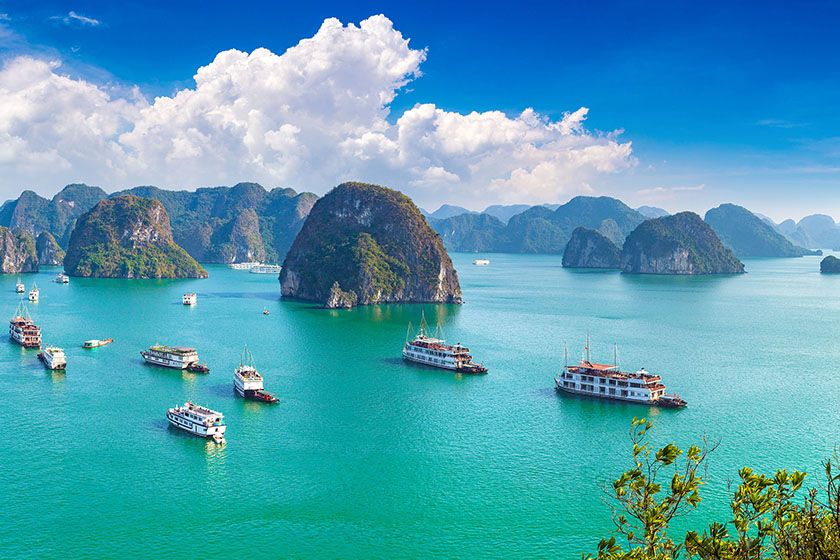
Bout tours around Ha Long Bay © S-F/Shutterstock
Little Hoi An has an almost bewildering selection of mouth-wateringly good restaurants, offering up specialities, such as Cao Lau – rice-flour noodles in soup flavoured with mint and star anise, topped with slices of pork, bean sprouts and pork-rind croutons. The elegant restaurant Morning Glory is one of the best places to try it, along with other superbly prepared dishes, for a reasonable price. You can also try your hand at Vietnamese cooking by taking one of many cookery classes available in town.
Discover 10 Vietnamese foods you need to try.
An exploration of Ha Long Bay in northern Vietnam is a must for any visit to Vietnam. Dramatic limestone rock formations which jut straight up from the water make up the two thousand or so forested islands. Visit the enchanting caves via one of the tours available and, if you can, make time for one of the three-day tours, as you get to spend a night at sea. Swimming and kayaking around the bay’s bright green waters is a glorious experience.
On a clear day the views around Sa Pa in the far north of Vietnam are breathtaking. Lush terraced rice fields line the steep valley and mountains loom from all sides. It’s the gateway to fantastic trekking country and the reason most visitors come here. Explore the Hoang Lien Son Mountain range, home to Fan Si Pan, Vietnam’s highest mountain, and visit the small ethnic communities still living a traditional way of life.
Picture postcard Phu Quoc island in the Gulf of Thailand is no longer a well-kept secret. Word is out about its powdery white-sand beaches facing glorious sunsets, its dense jungle, and the laid-back atmosphere of the island. But even though visitor numbers are up, there is still plenty of unspoiled creamy soft sand in which to dig your toes. You can also paddle around the bays in a kayak, or dive around the reefs, weaving among colourful tropical fish and perhaps a hawksbill turtle.
Around half of the island is part of a UNESCO-listed national park and remains pretty much untouched. You’ll find hiking trails in its tropical rainforests, and a fantastic array of wildlife.
Zipping on a motorbike is a great way to explore the island’s back roads and quiet fishing villages.
Dubbed the city of Eternal Spring for its year-round cool climate, this former hill station in the Central Highlands, with its winding streets and French colonial-era villas, is the place to head when the heat in cities below becomes stifling. Combine a visit to the splendid Bao Dai’s Summer Palace with the Crazy House, a fairytale riot of twisted cement.
But it’s the area surrounding Da Lat that’s the big draw. Fragrant pine forests and dramatic waterfalls beckon, and alongside hiking there’s the opportunity for mountain biking and rock climbing – or, for those seeking greater thrills, canyoning. You can also rent a motorbike for a bit of adventure, and it’s a great way to explore more of the area.
For a more sedate experience, enjoy the beautiful view via the cable car to the Truc Lam Pagoda.
This spectacular nature reserve in the northern coastal area of Vietnam is as yet comparatively unknown to outsiders. Trek amid magnificent rice terraces, and visit the white Thai or Muong minority groups, some of which offer home-stay accommodation. You can help prepare a meal and join in with family life, and then bed down in a thatched stilthouse.
A visit to Vietnam wouldn’t be complete without a visit to its capital city. Hanoi, with its constant buzz of motorbikes and general hubbub is the place to experience city life at full throttle. Wander the sinuous streets of the Old Quarter, with its narrow red roofed tube-houses, temples and pagodas, and whir of street vendors. Perch on a plastic stool and watch the hectic world go by over a cup of Vietnamese coffee or glass of beer.
Check out the atmospheric French Quarter, with its impressive Opera House, and visit the many cultural and historical sites, such as the Ho Chi Minh Mausoleum and Museum of Ethnology.
Everywhere you go you’ll be hit with the scent of delicious street food, such as the traditional breakfast dish of pho, a beef noodle soup.

Busy streets of Hanoi © John Bill/Shutterstock
The carefully created travel itineraries in our Vietnam travel guide will inspire and help you make the most of your trip. Combining the classic tourist sights and busy cities with laidback beaches, quiet temples and remote mountain villages, where you’d be hard-pushed to find another visitor, there’s an itinerary to match your interests and suit your time frame – whether you have a month to travel in Vietnam, or just a week or two. And don’t worry about seeing everything – each of the routes will give you a good taste of the country.
Meet your Vietnam local travel expert

22 days / from4799 USD
The Ultimate Southeast Asia Grand Tour
Explore the highlights of four countries in a bit over 3 weeks: Halong Bay & the Mekong Delta in Vietnam combined with the cities Hanoi and Ho Chi Minh City. Proceed to Cambodia with Angkor Wat before watching the monks in Luang Prabang/Laos. Your trip ends in Thailand with elephants and Bangkok.
view tour ⤍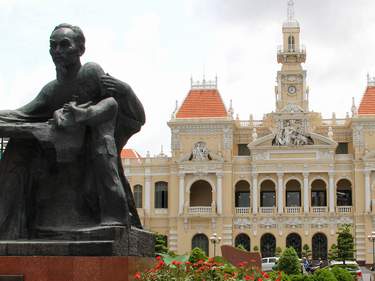
13 days / from2260 USD
Retrace the Vietnam War
Visit the highlights of Vietnam while tracing parts of the war across the country. Notable sights include Cu Chi Tunnels, Ba Den Battlefield, Son My, the Demilitarized Zone that divided North and South Vietnam, as well as museums and more in Hanoi. End your trip with a leisurely Halong Bay cruise.
view tour ⤍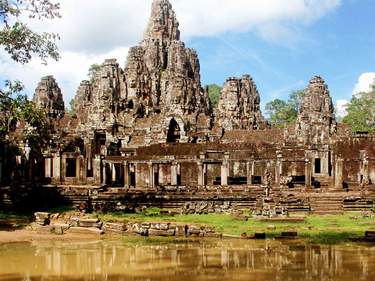
21 days / from4545 USD
Impressions of Vietnam, Cambodia and Laos
Start and end your trip in Ho Chi Minh City and visit highlights such as the Mekong Delta, Phnom Penh with the Killing Fields, Angkor Wat, the historic city of Luang Prabang in Laos before heading back to Vietnam - Hanoi, Halong Bay and Hoi An await.
view tour ⤍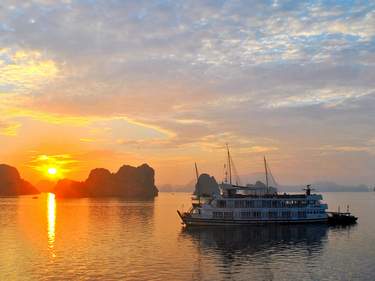
14 days / from2947 USD
Vietnam and Laos - Highlights and Exploration
Start your trip in Ho Chi Minh City (former Saigon) and explore the city and the Mekong Delta. From here, you make your way to Central Vietnam with Hue and Hoi An before Hanoi and Halong Bay await. Afterwards, catch a flight to Laos and spend your remaining nights in fascinating Luang Prabang.
view tour ⤍_listing_1680672625412.jpg)
12 days / from2499 USD
Vietnam for Families
Travelling with family? Explore the best areas of Vietnam with suitable activities for the whole family. Hanoi and Ho Chi Minh City are of course part of it, so is Halong Bay, a boat tour in the Mekong Delta, as well as the beautiful ancient town of Hoi An.
view tour ⤍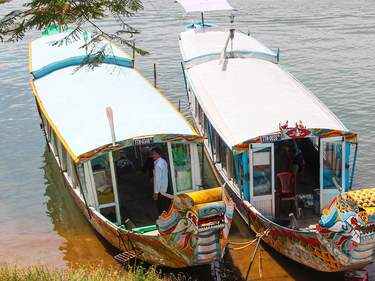
14 days / from2469 USD
Classic Vietnam and Cambodia
Start your Southeast Asia adventure in Hanoi with a city tour and then proceed to Halong Bay for a luxurious cruise. In Central Vietnam, you will visit Hoi An and Hue before flying to Ho Chi Minh City. Discover the Mekong Delta and the Cu Chi Tunnels before your final stop - Angkor Wat in Cambodia.
view tour ⤍
14 days / from2655 USD
Vietnam for Romantics
Planning a special trip with your beloved? Vietnam is the ideal mix of culture (Hoi An, Ho Chi Minh City) paired with nature (Halong Bay, Mekong Delta) and ending the trip on picturesque Phu Quoc - crystal clear water and white sandy beaches included!
view tour ⤍
15 days / from3715 USD
Signature Vietnam & Thailand
Discover 3 main areas in each country: Vietnam with Ho Chi Minh City, Hanoi and the Halong Bay. Thailand with Bangkok, Chiang Mai and Phuket. Discover authentic food experiences, historic city tours with knowledgeable guides and much more on this two week itinerary.
view tour ⤍
3 days / from544 USD
Three Day Sapa Tour from Hanoi
Your private guide and car will take you through winding roads and terraced rice fields to Silver Waterfall and Heaven Gate for stunning views of Lai Chau Valley and Fanxipan mount. Spend a night in Sapa and visit the bustling market to see ethnic minority groups selling their handicrafts.
view tour ⤍
2 days / from405 USD
Unique Mekong Delta from Saigon
Visit the bustling floating markets, local workshops, fruit orchards, and rice paddies, as well as cycle through the countryside and mingle with the friendly locals. You will cruise along the Mekong river to An Binh island, cycle through the orchards, visit floating markets and much more.
view tour ⤍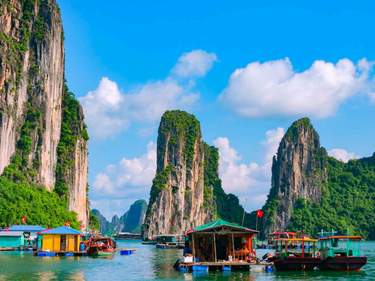
2 days / from419 USD
Premium Halong Bay Cruise
Sail through the emerald waters of Halong Bay and marvel at the limestone cliffs, scattered islets, and floating fishing villages. Enjoy a range of activities, including kayaking, swimming, and cave exploration, while indulging in delicious Vietnamese cuisine.
view tour ⤍If you have a month to travel around Vietnam the Grand Tour could be the one for you: it’s the classic itinerary, packing in the essential sights, bustling cities, beautiful beaches, rural Vietnam, and much more. If you have a week or two and want to focus on Vietnam’s ethnic minority groups residing in the north, the Ethnic Culture tour is ideal. And if you have just a week and want to get off the beaten track go for the Unseen Mekong Delta itinerary.
Below is a sample itinerary, ideal for the first-time visitor to Vietnam, but you can see all our itineraries here.
You’ll get a taste of everything with this itinerary: big cities, historical and cultural sights, idyllic beaches, boat trips, intriguing caves, unspoiled countryside, homestays in rural villages, and more. Allow sixteen days, or longer if you want to take things at a more relaxed pace.
Start off your tour in Vietnam’s capital and enjoy its busy yet laid-back vibes. Visit some of the principal sights in Hanoi: the Ho Chi Minh Mausoleum, and the nearby One-Pillar Pagoda, the Military History Museum, or the Ethnology Museum, and the Temple of Literature, Vietnam’s principal Confucian sanctuary and its historical centre of learning. Wander around the Old Quarter and take a stroll around Hoan Kiem Lake. Sample delicious street food and watch a traditional water puppet show in one of the famous theatres.
Take a two-day boat tour around some of the two thousand or so dramatic limestone islands and intriguing caves of the World Heritage Site Ha Long Bay, Vietnam’s top draw. Enjoy the magical scenery while swimming in the emerald green waters around Titov island beach. Tours can be arranged from Hanoi.
Just a few hours away by road Hanoi, The Mai Chau valley is largely unspoiled.
Hop on a bicycle and explore the surrounding rice paddies nestled against forested mountains, and wander around Mai Chau’s bustling morning market. Then visit the nearby White Thai villages to spend the night in a homestay.
Drive to Ninh Binh, the ideal base from which to visit beautiful Tam Coc, essentially a miniature landlocked version of Ha Long Bay, and an easy cycle ride from Ninh Binh. Take a boat trip through the limestone tunnels and between karst hills to the three long, tunnel caves at Tam Coc itself.
Travel to the engaging city of Hue and take a day-long boat trip along the Perfume River to visit the Thien Mu Pagoda and Hon Chen Temple, the Imperial City, and the Tu Duc mausoleum. At the end of the day have a wander through the lively Dong Ba Market.
The next morning take a bicycle, or tour by cyclo, along the north bank of the river to tranquil Kim Long village, where mandarins and other Imperial officials built their houses surrounded by lush gardens, in the late nineteenth century.
Drive to Da Nang via the Hai Van Pass, or “Pass of the Ocean Clouds”, taking in the superb views of Da Nang Bay. Stop off at the Cham Museum in Da Nang, with its impressive display of terracotta and sandstone figures. Then continue to Hoi An.
Wander the narrow streets, soaking up historic Hoi An’s charming old-world atmosphere, with its old merchants houses and wooden-fronted shops. Visit some of the sights, such as the Phuoc Kien assembly hall, the Museum of History and Culture and the beautifully preserved eighteenth-century Tan Ky House. It’s worth tying in your visit to coincide with its monthly lantern festivals – candle-lit paper lanterns meandering down the river is a magical sight.
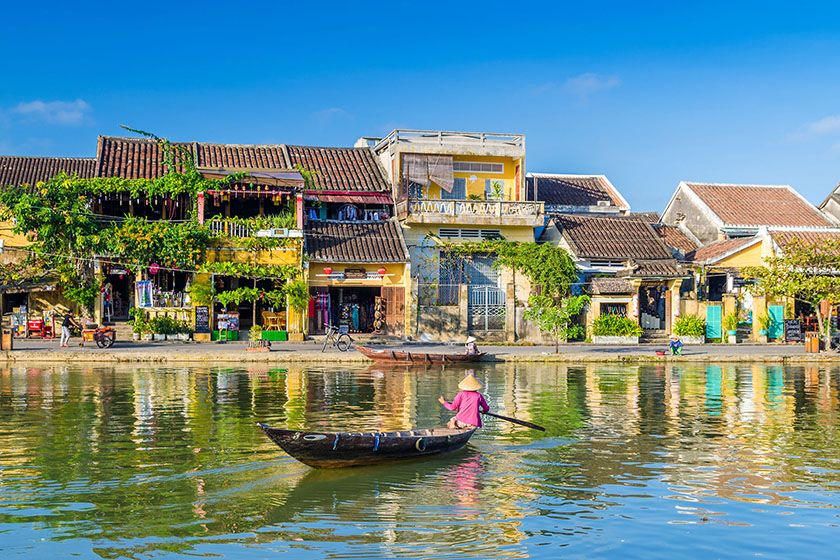
The riverside town of Hoi An © Judyta Jastrzebska/Shutterstock
Cosmopolitan Nha Trang combines cultural highlights with stylish restaurants and lively bars, and 6km of glorious sandy coastline offering prime opportunities for swimming, snorkeling and other watersports.
Visit the wonderful Po Nagar Cham towers, built between the seventh and twelfth centuries by the Hindu Cham people, and then take a look around the Long Son Pagoda.
Then head for one of the city’s gorgeous beaches, such as Tran Phu beach, closest to the city action and backed by a great promenade, the quieter Hon Chong beach, or the more secluded and pristine Bai Dai beach.
7. Da Lat
Move on to Da Lat, 1500km high in the Lang Bian Plateau. Visit the splendid Summer Palace of Emperor Bao Dai, and the gaudy Crazy House. Enjoy the Da Lat flower gardens and then set off for Ho Chi Minh City, stopping en route to visit tea, coffee, or rubber plantations.
Embrace the bustle of the metropolis and see some of city’s main sights: the Notre Dame Cathedral, the History Museum, the Jade Emperor Pagoda, the Reunification Palace, the War Remnants Museum. Take a wander around Cho Lon, the city’s Chinatown, sample street food at Ben Thanh market and, come sundown, stroll along pedestrianized Nguyen Hue.
Take a day-trip from Ho Chi Minh City to the Cu Chi tunnels at Ben Dinh or Ben Duoc, a system of tunnels created by the Viet Cong during the Vietnam war.
An alternative day-trip is to the wonderful countryside around Ben Tre in the Mekong Delta. Explore by boat the many creeks along the Ben Tre coastline and stop off at rice-wine and sugar processing workshops.
From travel safety to visa requirements, discover the best tips for traveling to Vietnam
Before you go to Vietnam, make sure you have up-to-date travel advice. From insurance information to shop opening hours, tipping etiquette to advice on travelling with kids – our Vietnam travel guide offers tips and advice to cover all you need to know.
Vietnam’s unit of currency is the dong, which you’ll see abbreviated as “đ”, “d” or “VND” after an amount. The American dollar is also widely used and it’s a good idea to carry some dollars as a back-up to pay large bills.
Daily expenses, for example, admission charges to historic sites, for food and drink (especially if you do as the locals do), are low, and it’s almost always possible to haggle. Tipping, while not expected, is always appreciated – 10% is the norm in a restaurant.
For budget accommodation expect to pay between $6-10 for a bed in a dormitory, $15-25 for a simple private room; allow between $35-80 for mid-range accommodation, and for high end the sky’s the limit.
Temples and pagodas are usually free.
Vietnamese society is both conservative and fairly tolerant, so it’s best to follow these simple rules to avoid causing offence: shorts and sleeveless tops fine for the beach, not so at religious sites, and nudity on the beach is a no-no. Women in particular should dress modestly.
As in most Asian countries, it’s not normal to get outwardly angry. Passing round cigarettes (to men only) is always appreciated and is widely used in negotiations, bargaining and so forth.
The electricity supply in Vietnam is 220 volts. Plugs generally have two round pins, though you may come across sockets accepting two flat pins and even some that take three pins. Power supplies can be erratic in the sticks, so be prepared for cuts and surges.
It is essential to have a good travel insurance policy to cover against theft, loss and illness or injury. It’s also advisable to have medical cover that includes evacuation in the event of serious illness, especially if you’re doing any motorbike touring. Check your policy specifically covers you for motorbiking in Vietnam and ascertain whether benefits will be paid as treatment proceeds or only after you return home, and whether there is a 24-hour medical emergency number). If you’re planning on doing any ‘dangerous’ sports, check your policy for cover.
In the event that you have anything stolen, you must obtain an official statement from the police.
In the major cities and tourist centres, most cafés and hotels provide wi-fi, and smaller towns are catching up. Unfortunately, some top-end hotels still charge a hefty fee for the privilege of getting online.
Basic hours of business are 7.30–11.30am and 1.30–4.30pm. The standard closing day for offices is Sunday, and many now also close on Saturdays, including most government offices. Most banks tend to work Monday to Friday 8–11.30am and 1–4pm, but there are variations, with some open evenings and weekends, so check. Post offices generally stay open from 6.30am until 9pm.
Shops and markets open seven days a week and in theory keep going all day, though in practice most stallholders and many private shopkeepers will take a siesta. Shops mostly stay open late into the evenings, perhaps until 8pm or beyond in the big cities.
Officially, homosexuality is regarded as a “social evil”, alongside drugs and prostitution. However, there is no law explicitly banning homosexual activity and, as long as it is not practised openly, it is largely ignored. For more information, consult the excellent Utopia Asia website.
If you want to use your own mobile phone in Vietnam, the simplest – and cheapest – thing to do is to buy a SIM card locally (or even a phone, if your own is locked). It’s best to go to stores run by the major operators – you’ll find them at the major international airports (bring your passport, too).
Few provisions are made for the disabled, and so it’s important to contact airlines, hotels and tour companies as far in advance as possible to make sure they can accommodate your requirements. Getting around can be made a little easier by renting a private car or minibus with a driver; taxis are also widely available in all cities.
The Vietnamese adore kids and make a huge fuss of them. The main concern will probably be hygiene, as Vietnam can be distinctly unsanitary. So avoiding spicy foods will help while their stomachs adjust. Bear in mind that healthcare facilities can remain basic outside Hanoi and Ho Chi Minh City, so make sure your travel insurance includes full medical evacuation.
There are reduced fares for children on domestic flights, trains and open-tour buses. On trains, for example, it’s free for under-5s (as long as they sit on your lap) and half-price for children aged 5 to 10.
Without a prearranged job and work permit, you shouldn’t bank on finding work in Vietnam. English-language teaching is probably the easiest job to land, especially if you have a TEFL, TESOL or CELTA qualification. You’ll need to apply for a work permit, sponsored by your employer, and then a working visa.
The main English-language teaching operations recruiting in Vietnam include the British Council, ILA Vietnam Language Link Vietnam and RMIT International University. The TEFL website and Dave’s ESL Café also have lists of English-teaching vacancies in addition to lots of other useful information.
There are also opportunities for volunteer work. Check the websites of the VUFO-NGO Resource Centre and Volunteer Abroad.

Sandy coastline of Nha Trang © HelloRF Zcool/Shutterstock
Most foreign nationals need a visa to visit Vietnam – citizens of some Asian and Nordic nations get 15–30 days visa-free, and from 2016 the government allowed the same of passport-holders from the UK, France, Germany, Italy and Spain, although this is for a limited time so do check with your local consulate.
To apply for tourist visas, you have to submit an application form with passport-sized photographs (procedures vary) and the fee. The visa is valid for entry via Hanoi, Ho Chi Minh City and Da Nang international airports and any of Vietnam’s land borders open to foreigners.
Visas are generally valid for thirty days, though longer durations can be arranged; make an application in any Vietnamese embassy or consulate, or through a specialist agent, although it’s quicker (a few days, as opposed to around a week) to get a “visa on arrival” online. There are several reliable websites offering this service, such as the Vietnam Visa Center.
Present your approval letter, photographs (they can take one at the airport, for a fee) and application form (available at airport desks) to immigration on arrival, and the stamping fee. The process is very easy and efficient but note that they can only be picked up at Hanoi, Ho Chi Minh City or Da Nang airports, not at land border crossings.
Thirty-day extensions can be arranged at travel agencies in Hanoi, Ho Chi Minh City, Nha Trang, Da Nang, Hue and Hoi An. In general, they take three days to process and cost from US$25. Overstaying your visa will result in a fine of US$10–25 per day, and border staff at the airport may insist that you head back into the nearest city, in order to pay the fine at an immigration office.
A full list of Vietnamese embassies and consulates is available at Vietnam Visa Center.
Business visas are valid for one month upwards and can be issued for multiple entry, though you’ll need a sponsoring office in Vietnam to underwrite your application.
One-year student visas are relatively easy to get hold of; for example, if you enrol on a Vietnamese language course at one of the universities, though you’ll be required to attend a minimum number of classes per week to qualify. It’s easiest to arrange it in advance, but you can enter Vietnam on a tourist visa and apply for student status later – the only downside is that you may have to leave the country in order to get the visa stamp.
Vietnam is a relatively safe country for visitors and the Vietnamese are generally welcoming to foreign visitors. Petty crime is on the rise on a relatively small-scale and shouldn’t be a problem if you take common-sense precautions: don’t wear expensive jewellery, carry your passport and other important documents concealed in a money belt, and keep a close eye on your bags when travelling on public transport, particularly if they’re on a luggage rack, or on top of a bus.
Also, when walking or riding in a cyclo you are vulnerable to moped-borne snatch thieves, so don’t wear cameras or expensive sunglasses hanging round your neck.
The place you are most likely to encounter street crime is in Ho Chi Minh City, which has a fairly bad reputation for bag-snatchers, pickpockets and con artists. Be wary of innocent-looking kids and grannies who may be acting as decoys for thieves – especially in popular tourist hangouts.
Petty crime is also a problem in Nha Trang, where you should watch your belongings at all times on the beach. Be wary of taking a cyclo after dark and women should avoid walking alone at night.
Unexploded ordnance from past conflicts still poses a threat in some areas. Wherever you are, stick to well-trodden paths and never touch any shells or half-buried chunks of metal.
Possessing or selling prohibited drugs in Vietnam is extremely unwise. Drug laws in Vietnam are strict, with fines and jail sentences are imposed for lesser offences, while the death penalty is regularly imposed for possessing, trading or smuggling larger quantities.
For solo female travellers, Vietnam is generally a safe country. However, it’s best to take the normal precautions if you’re a woman travelling alone; avoid taking a cyclo by yourself, and use taxis from a reputable agency.
(Last updated: October 2019)
Use Rough Guides' trusted partners for great rates
written by Rough Guides Editors
updated 9.10.2023
Plan your tailor-made trip with a local expert
Book securely with money-back guarantee
Travel stress-free with local assistance and 24/7 support
Frankie
We wanted to write and commend one of your tour guides - Nina, who has spent to days with us in Bangkok, staying along the river. Nina is the most professi...
Read all reviews ⤍